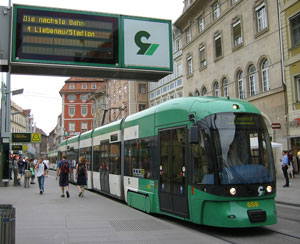|
|||
|
 |
| Public Travel Information Systems in Graz (© Salzburg Research). |
During our work we have found a number of requirements for middleware systems dealing with stationary and mobile devices in public information systems. The most important of these are:
- Heterogeneity of devices: PTIS must cope with a multitude of devices, including personal computers, public information terminals, videowalls, LED displays and also mobile devices, such as PDAs (Personal Digital Assistants) and mobile phones.
- Variability in connection modes - the off-line mode: The use of mobile devices implies that not all devices will be available all the time; in mobile environments, devices are regularly off-line, and as a result, the off-line mode cannot be considered to be an exception. Consequently, the middleware infrastructure must be capable of caching data in the off-line mode and redistributing it upon reconnection through the use of sophisticated data synchronisation mechanisms.
- Centralised configuration and 'Plug & Work' capability: Another issue involves the accessibility of mobile devices in large systems for configuration and management purposes. For example, a huge number of information displays in train stations cannot be physically accessed. Consequently, the configuration data for these devices should be minimised, and in general they should be configured, maintained and monitored through a central management tool. Using a central management tool ('Control Center') with automatic data distribution allows the easy maintenance of a huge number of devices with similar configurations. This also allows the so-called 'Plug & Work', ie the dynamic configuration of devices during run-time.
- Quality of information: The quality as perceived by the customer, ie traveller, is measured by the quality of the information delivered. This requires information to be synchronised and updated regularly.
Under consideration of the requirements and aims mentioned above, we have adopted the following technical solutions. The middleware infrastructure is based on an overlay network structure with a hierarchical, two-tier network scheme. This means that, despite the underlying physical network, mobile devices are dynamically assigned to logical sub-domains within one global domain, enabling efficient device management, message routing and allocation of the necessary infrastructure. In order to provide a simple and efficient programming model for developers, software infrastructure on devices had to be structured appropriately. The concept of a service-oriented architecture (SOA), defining services as coarse-grained functional units with well-known interfaces, was therefore adopted. Following the requirements for mobile devices, services are allowed to use different communication modes like synchronous RPC and asynchronous 'Store and Forward' messaging. Reliable data distributed to mostly off-line devices required the development of a data-distribution mechanism called Virtual Database (VDb). With Virtual Database it is possible to provide services with a virtual database connection without establishing a real connection. VDb hides the necessary communication details from the developer and improves the efficiency of data distribution. Services ask the VDb for database fragments and get these either from the local cache or upon network connection directly from the database. VDb is used for the distribution of configuration data and management data, and is also well suited for multimedia content.
Another of our technical aims is the support of a broad variety of heterogeneous devices. This was achieved through the use of widely adopted standards such as Web Services, and through building upon platforms which are also available for embedded devices. While our first prototype was based on the Java 2 platform, requirement changes demanded that the current prototype be developed using the .net Framework. In the future, we are planning to support the .net Compact Framework on embedded Windows.CE devices as well.
In conclusion, we have argued for requirements for next-generation transport information systems and have outlined how we are addressing these issues with respect to the middleware layer. The concept of Service-Oriented Architecture was carefully chosen in order to overcome platform borders and to simplify the process of porting code to other platforms.
Link:
http://www.suntrec.at
Please contact:
Siegfried Reich, Salzburg Research
Forschungsgesellschaft m.b.H./AARIT
Tel: +43 662 2288 200
E-mai: sreich@suntrec.at


